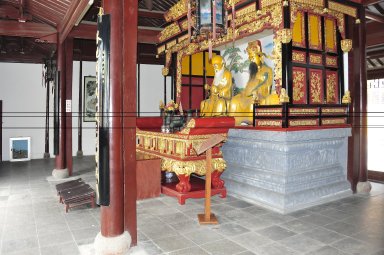Detail View: Archivision Base to Module 9: Xuanmiao Temple

|
Preferred Title:
|
Xuanmiao Temple
|
|
Alternate Title:
|
Xuanmiaoguan
|
|
Image View:
|
Hall of Longevity with shrine of gods of Longevity (left), Emolument or Prosperity(center) and Happiness (right)
|
|
Creator:
|
unknown (Chinese)
|
|
Location:
|
site: Suzhou, Jiangsu, China
|
|
Location Note:
|
old Suzhou City; 94 Guanqian St. (Guan Qian Jie)
|
|
GPS:
|
+31.314444+120.621944
|
|
Date:
|
1179-1181 (creation)
|
|
Cultural Context:
|
Chinese
|
|
Style Period:
|
Southern Song
|
|
Work Type 1:
|
temple
|
|
Work Type 2:
|
monastery
|
|
Classification:
|
architecture
|
|
Material:
|
wood
|
|
Technique:
|
carving (processes); construction (assembling)
|
|
Measurements:
|
26 m (height) x 25 m (width) x 45 m (length, Sanqing dian hall)
|
|
Description:
|
The Xuanmiao guan ("Monastery of Mystery"), is one of the oldest Daoist halls in China and was completed between 1179 and 1181. It is a rare surviving example of Southern Song (1127-1279) wood architecture, which probably still retains much of its original form despite later repairs and remodeling. Its construction was apparently based on the tenets expounded in the architectural manual Yingzao fashi ("Building standards"; 1103) and served as a model for later Japanese construction. The main hall of the monastery is dedicated to the Three Pure Ones (Sanqing dian). The entrance hall, the Zhang Shan Men, is also wood, rebuilt in 1775. The complex has seven halls; to the east of the Sanqing dian are Wenchang Hall, the Doumu Pavilion and the Shouxing Hall. The western side includes Leizun or Leishen (God of Thunder) Hall and the Caishen (God of Wealth) Hall. (Source: Grove Art Online; http://www.oxfordartonline.com/)
|
|
Image Description:
|
Fu, Lu, and Shou is the concept of Happiness (Fu), Prosperity (Lu), and Longevity (Shou). This concept of the Chinese traditional religion is thought to date back to the Ming Dynasty.
|
|
Collection:
|
Archivision Addition Module Nine
|
|
Identifier:
|
1A2-CH-SH-SX-J34
|
|
Rights:
|
© Scott Gilchrist, Archivision, Inc.
|